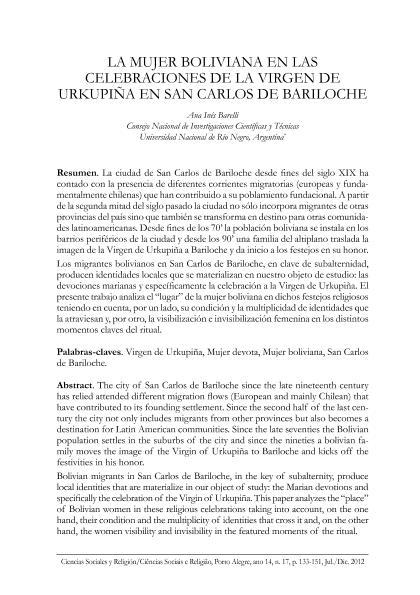Mostrar el registro sencillo del ítem
dc.contributor.author
Barelli, Ana Inés

dc.date.available
2017-01-13T20:57:35Z
dc.date.issued
2012-12
dc.identifier.citation
Barelli, Ana Inés; La mujer boliviana en las celebraciones de la Virgen de Urkupiña en San Carlos de Bariloche; Universidade Federal do Rio Grande do Sul; Ciencias Sociales y Religion; 14; 17; 12-2012; 133-151
dc.identifier.issn
1518-4463
dc.identifier.uri
http://hdl.handle.net/11336/11347
dc.description.abstract
La ciudad de San Carlos de Bariloche desde fines del siglo XIX ha contado con la presencia de diferentes corrientes migratorias (europeas y fundamentalmente chilenas) que han contribuido a su poblamiento fundacional. A partir de la segunda mitad del siglo pasado la ciudad no sólo incorpora migrantes de otras provincias del país sino que también se transforma en destino para otras comunidades latinoamericanas. Desde fines de los 70’ la población boliviana se instala en los barrios perifericos de la ciudad y desde los 90' una familia del altiplano traslada la imagen de la Virgen de Urkupiña a Bariloche y da inicio a los festejos en su honor. Los migrantes bolivianos en San Carlos de Bariloche, en clave de subalternidad, producen identidades locales que se materializan en nuestro objeto de estudio: las devociones marianas y específicamente la celebración a la Virgen de Urkupiña. El presente trabajo analiza el “lugar” de la mujer boliviana en dichos festejos religiosos teniendo en cuenta, por un lado, su condición y la multiplicidad de identidades que la atraviesan y, por otro, la visibilización e invisibilización femenina en los distintos momentos claves del ritual.
dc.description.abstract
The city of San Carlos de Bariloche since the late nineteenth century has relied attended different migration flows (European and mainly Chilean) that have contributed to its founding settlement. Since the second half of the last century the city not only includes migrants from other provinces but also becomes a destination for Latin American communities. Since the late seventies the Bolivian population settles in the suburbs of the city and since the nineties a bolivian family moves the image of the Virgin of Urkupiña to Bariloche and kicks off the festivities in his honor. Bolivian migrants in San Carlos de Bariloche, in the key of subalternity, produce local identities that are materialize in our object of study: the Marian devotions and specifically the celebration of the Virgin of Urkupiña. This paper analyzes the “place” of Bolivian women in these religious celebrations taking into account, on the one hand, their condition and the multiplicity of identities that cross it and, on the other hand, the women visibility and invisibility in the featured moments of the ritual.
dc.format
application/pdf
dc.language.iso
spa
dc.publisher
Universidade Federal do Rio Grande do Sul
dc.rights
info:eu-repo/semantics/openAccess
dc.rights.uri
https://creativecommons.org/licenses/by-nc-sa/2.5/ar/
dc.subject
Virgen de Urkupiña
dc.subject
Mujer Devota
dc.subject
Mujer Boliviana
dc.subject
San Carlos de Bariloche
dc.subject.classification
Otras Historia y Arqueología

dc.subject.classification
Historia y Arqueología

dc.subject.classification
HUMANIDADES

dc.title
La mujer boliviana en las celebraciones de la Virgen de Urkupiña en San Carlos de Bariloche
dc.type
info:eu-repo/semantics/article
dc.type
info:ar-repo/semantics/artículo
dc.type
info:eu-repo/semantics/publishedVersion
dc.date.updated
2017-01-13T19:15:50Z
dc.identifier.eissn
1982-2650
dc.journal.volume
14
dc.journal.number
17
dc.journal.pagination
133-151
dc.journal.pais
Brasil

dc.journal.ciudad
Porto Alegre
dc.description.fil
Fil: Barelli, Ana Inés. Consejo Nacional de Investigaciones Científicas y Técnicas. Centro Científico Tecnológico Patagonia Norte. Instituto de Investigaciones En Diversidad Cultural y Procesos de Cambio; Argentina. Universidad Nacional de Rio Negro; Argentina
dc.journal.title
Ciencias Sociales y Religion

dc.relation.alternativeid
info:eu-repo/semantics/altIdentifier/url/http://seer.ufrgs.br/index.php/CienciasSociaiseReligiao/article/view/29807
Archivos asociados
